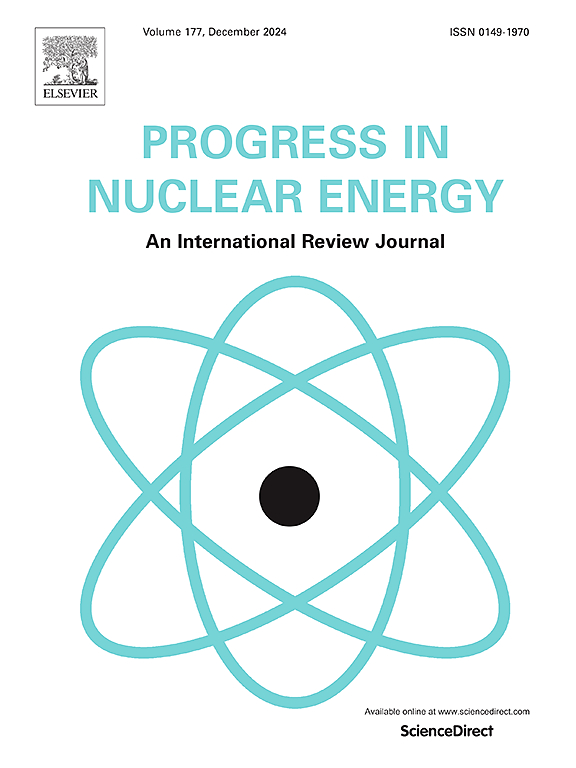Computational model for prediction of water level inside Vertical U-tube Steam Generators (UTSGs) of typical PWR
IF 3.2
3区 工程技术
Q1 NUCLEAR SCIENCE & TECHNOLOGY
引用次数: 0
Abstract
Maintaining water level inside steam generators in a typical Pressurized Water Reactor (PWR) particularly during low power has always been a significant challenge in the operation of Nuclear Power Plants (NPPs). Variation in power leads to fluctuations in the water level and stabilizing the water level in the steam generator prevent damage to turbines, core and tripping of reactors. This research presents a computational model for predicting water levels in U-tube vertical steam generators (UTSGs) of PWRs during transients. The model's level predictive capability was validated through cross-calculations with actual data of Nuclear Power Plant (NPP). The methodology involves developing computational frameworks from the Irving model and collecting extensive data from existing PWR systems of NPPs to assess model accuracy. The results demonstrated that the predictive control method effectively maintained optimal water levels within the steam generators, minimizing discrepancies between predicted and actual values. The ramp response consistently provided smoother and more accurate predictions that closely matched the behavior of the actual system. The cross calculations with actual data further substantiate the model's effectiveness, demonstrating its potential as a reliable tool for real time monitoring and control in steam generators. These findings contribute to the improvement of safety and efficiency in nuclear power plant operations.
典型压水堆立式u管蒸汽发生器(UTSGs)内水位预测计算模型
在典型的压水堆(PWR)中,保持蒸汽发生器内部的水位,特别是在低功率下,一直是核电站运行中的一个重大挑战。功率的变化导致水位的波动,稳定蒸汽发生器的水位可以防止损坏涡轮机、堆芯和反应堆跳闸。本文提出了一种预测压水堆u型管垂直蒸汽发生器(UTSGs)瞬态水位的计算模型。通过与998MWth/340MWe核电站实际数据的交叉计算,验证了该模型的水平预测能力。该方法包括从欧文模型中开发计算框架,并从现有的998MWth/340MWe核电站的压水堆系统中收集大量数据,以评估模型的准确性。结果表明,预测控制方法有效地保持了蒸汽发生器内的最佳水位,最大限度地减少了预测值与实际值之间的差异。斜坡响应始终提供更平滑、更准确的预测,与实际系统的行为密切匹配。与实际数据的交叉计算进一步证实了该模型的有效性,证明了其作为蒸汽发生器实时监测和控制的可靠工具的潜力。这些发现有助于提高核电站运行的安全性和效率。
本文章由计算机程序翻译,如有差异,请以英文原文为准。
求助全文
约1分钟内获得全文
求助全文
来源期刊

Progress in Nuclear Energy
工程技术-核科学技术
CiteScore
5.30
自引率
14.80%
发文量
331
审稿时长
3.5 months
期刊介绍:
Progress in Nuclear Energy is an international review journal covering all aspects of nuclear science and engineering. In keeping with the maturity of nuclear power, articles on safety, siting and environmental problems are encouraged, as are those associated with economics and fuel management. However, basic physics and engineering will remain an important aspect of the editorial policy. Articles published are either of a review nature or present new material in more depth. They are aimed at researchers and technically-oriented managers working in the nuclear energy field.
Please note the following:
1) PNE seeks high quality research papers which are medium to long in length. Short research papers should be submitted to the journal Annals in Nuclear Energy.
2) PNE reserves the right to reject papers which are based solely on routine application of computer codes used to produce reactor designs or explain existing reactor phenomena. Such papers, although worthy, are best left as laboratory reports whereas Progress in Nuclear Energy seeks papers of originality, which are archival in nature, in the fields of mathematical and experimental nuclear technology, including fission, fusion (blanket physics, radiation damage), safety, materials aspects, economics, etc.
3) Review papers, which may occasionally be invited, are particularly sought by the journal in these fields.
 求助内容:
求助内容: 应助结果提醒方式:
应助结果提醒方式:


